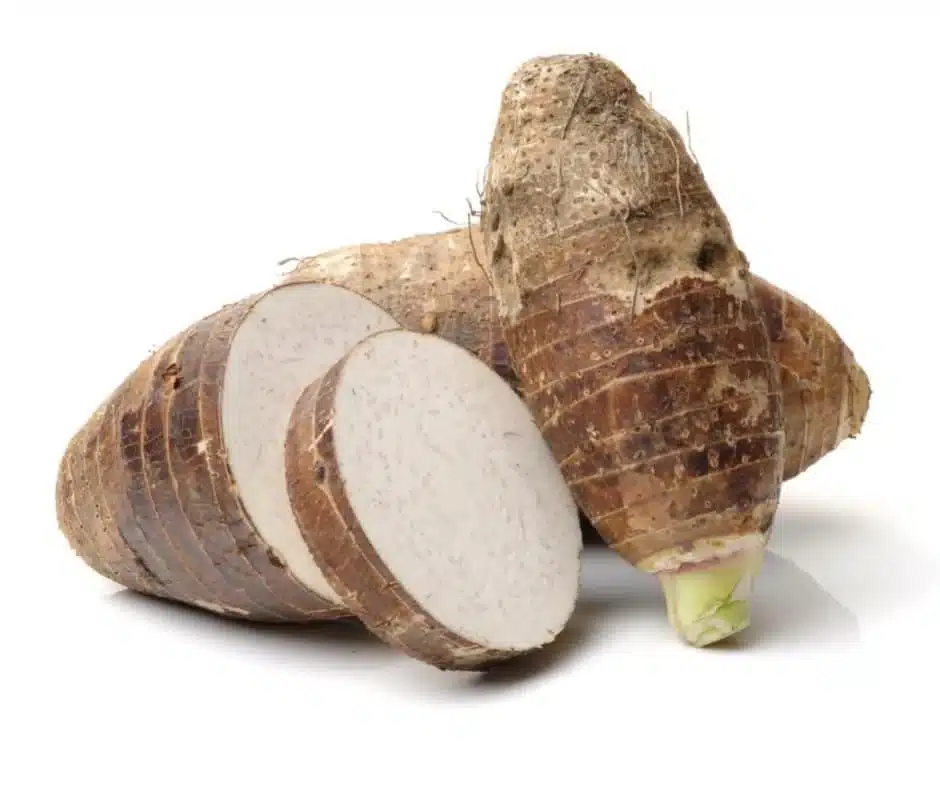What Does Taro Taste Like?
If you’ve been exploring the world of exotic flavors, you’ve likely come across taro in your culinary journey. But what exactly is taro? What does it taste like?
Taro is an ingredient used extensively in many cultures and cuisines – it’s a starchy root vegetable much like a potato, but with its unique texture and flavor.

This versatile ingredient can pop any dish with its pungent aroma and earthy, nutty taste. In this article, we’ll look at the taste of taro and some creative ways to use this delicious vegetable in your cooking!
Contents
What Is Taro?
Taro is a tropical root vegetable popular in many Asian cultures for centuries. The taro plant grows in warm, wet climates; its edible parts are the tubers or corms of the Araceae family.
It has a tough, brownish exterior that peels away to reveal white flesh beneath. Although this part looks plain, you’ll find tiny purple spots inside when you cut it open.
Taro is also super popular on the Pacific Island and looks similar to a potato but with a purplish-brown color and rough exterior.
What Does Taro Taste Like?
So what does taro taste like? Taro’s unique flavor and texture set it apart from potatoes and other root vegetables. Its taste is earthy, nutty, and slightly sweet, with a hint of bitterness.
The texture of the taro is creamy yet firm – it’s not as fluffy as a potato but still has its unique character. Taro is similar to sweet potatoes but has a slightly more pungent aroma and flavor.
Fried, baked, or roasted taro tastes sweet and has a vanilla profile similar to sweet potato.
Is Taro Healthy?
Yes, taro is incredibly nutritious and full of vitamins and minerals. It’s a good source of dietary fiber and contains calcium, magnesium, iron, zinc, phosphorus, potassium and selenium. Taro is a great whole food.
Health Benefits of Taro
Taro also contains high levels of antioxidants, which can help reduce inflammation and fight free radicals in the body. Additionally, it has a low fat and calorie content, making it an ideal choice for those looking to eat healthily.
Taro Root vs Taro Powder
While taro root is this vegetable’s most common form, there are other forms, like taro powder or taro flour. Taro powder has a more concentrated flavor and can be used in savory sweet dishes.
It’s also much easier to work with as it doesn’t require any preparation – add it to your recipes, and you’re good to go!
Hawaii Taro Root vs Asian Taro Root
The taste of taro root may vary slightly depending on its type and origin. For example, Hawaii taro is sweeter and more delicate than Asian taro, which tends to be a bit more bitter with a nutty flavor.
No matter what type of taro you choose, you can look forward to an earthy, nutty flavor.
Can I Eat Raw Taro?
Taro root is safe to eat when cooked properly. However, raw taro contains calcium oxalate, which can trigger symptoms such as throat burning, gout, and kidney stones.
Not to worry, once cooked, taro is free of calcium oxalate, making it safe and healthy to eat!

When preparing the taro, peel it and boil it thoroughly before consuming it. Also, wear gloves when handling taro root, as the outer layer can cause irritations and discomfort on sensitive skin.
It’s also important to use separate utensils when handling raw taro to avoid cross-contamination.
Using Taro to Make Taro Boba Tea
Taro root is the perfect ingredient for making boba tea or taro bubble tea. The earthy sweetness of taro pairs perfectly with creamy, milky flavors like almond and coconut to create a delicious and unique beverage.

Simply mix up your favorite tea base, add some taro powder, top it off with chewy tapioca pearls and enjoy taro bubble tea.
Does Taro Tea Have Caffeine?
No, taro tea does not contain any caffeine. This is an ideal option for those looking to reduce their intake of the stimulant or just want a more mellow flavor to their bubble tea or taro smoothie.
What Does Taro Milk Tea Taste Like?
So, what does taro boba milk tea taste like? Taro bubble milk tea is a popular beverage that has become increasingly popular. It is made by steeping taro root powder, milk and syrup in tea.
The resulting drink has a mild sweet taste with an earthy taro flavor. For some people, taro boba milk tea tastes like a mild chocolate flavor.
Where to Get Taro Bubble Tea?
Taro boba, also known as taro bubble tea or taro milk tea, is a beverage that originated from Asia but is now enjoyed across the globe.
If you wish to taste taro bubble tea flavor while out and about, plenty of bubble tea shops sell delicious taro milk tea. These boba tea shops tend to be in the Asian food store areas, but they’re becoming more and more popular in other areas.
How to Cook Taro?
Taro is a delicious and versatile ingredient that can be cooked in many different ways. It’s great for boiling, steaming, mashing, roasting and grilling.

You can also use it to make desserts like taro pancakes or sweet potato pie. For savory dishes, try adding it to soups or stews for a unique flavor and texture.
To cook taro, boil it in a pot or steam your taro in an Instant pot with water or coconut milk. Fresh taro is delicious with other root vegetables such as purple sweet potatoes and yams. It also pairs well with meat, fish, tofu and mushrooms.
How to Cook Fried Taro Root
Cooking taro root doesn’t have to be complicated. Here’s a simple recipe for fried taro to help you make a delicious side dish.

What You’ll Need
- 2 large taro roots, peeled and cut into cubes
- 1/4 cup oil (canola or vegetable oil)
- Salt to taste
Instructions
- Heat the skillet over medium heat until the oil starts to shimmer.
- Add the cubed taro root and stir to coat with oil.
- Sprinkle salt over the taro and continue occasionally stirring for 15 minutes or until the cubes are crisp and lightly browned on all sides.
- Serve hot as a side dish or by itself as an appetizer!
Can You Freeze Taro?
Freezing taro may seem odd, but the answer is a definite yes! Taro is a root vegetable that is versatile and easy to prepare.
Its unique flavor adds depth and complexity to many dishes, so it’s worth preserving later. Just be sure to wash and peel before freezing, as the brown skin of taro can be rubbery even after cooking. Once peeled, chop into cubes or slices and store in sealed containers or vacuum-sealed bags.
For even better results, try blanching in boiling water before freezing; this will preserve the nutrients while avoiding freezer burn. You can now enjoy your favorite recipes with frozen taro all year round!
How to Tell if Taro Root Is Bad?
Need help telling if your taro root is bad? Here’s a helpful guide for determining the quality of your taro:
- Check if the roots are fresh by examining their color. They’re likely past their prime if they are browning or turning grey.
- Give it a sniff to check for an unpleasant odor. If it smells sour or musty, it’s probably gone bad.
- Try pressing down on the roots with your finger – if they feel the squishy and soft texture, they’ve most likely gone bad.
- Inspect the skin of the roots closely – if they have any visible mold growing on them, discard them immediately, as this indicates that they’ve gone bad.
- Test a small piece of the root by tasting it, but be sure not to eat too much, just in case! If it tastes sour or off, then you should discard it.
More Taro Root Recipes
Here are some Taro root recipes and food ideas that can be created using taro:
Taro in Coconut Milk
If you like coconut milk, make sure to give this a go – coconut milk pairs go well with taro!

Ingredients:
- 2 cups chopped taro
- 2 cups thick coconut milk
- 2 tablespoons of butter or oil
- 1 tablespoon of brown sugar
- Salt and pepper to taste
Method:
- Peel the taro root and chop it into small cubes.
- Heat the butter or oil in a pan over low to medium heat.
- Add the taro root and cook, occasionally stirring, until it softens (about 5 minutes).
- Simmer the coconut milk mixture, stirring in the sugar, salt and pepper to taste, for 10 minutes until the taro is cooked.
- Serve warm or cold, as desired. Enjoy!
Crispy Taro Fritters
These savory taro fritters are a delicious way to enjoy a classic dish. Made with simple ingredients and easy preparation, these crispy treats are perfect for snack time or as an appetizer!

Ingredients:
- 1 cup of mashed taro root
- 2 tablespoons of all-purpose flour
- ½ teaspoon of baking powder
- ½ teaspoon of turmeric powder (optional)
- Pinch of salt
- 2 tablespoons of chopped cilantro
- Oil for frying
Instructions:
- Mix the mashed taro root, flour, baking powder, turmeric powder (if used), salt and cilantro until well combined. If the mixture is too dry to shape into patties, add a splash of water or milk at a time until you reach desired consistency.
- Heat oil in a saucepan over medium to high heat. Carefully scoop 2 tbsp portions of the mixture using a spoon and gently flatten into patties. Fry on each side until golden brown and crispy.
- Serve warm with your favorite dipping sauce, and enjoy!
Air Fryer Taro Chips
These air-fried taro chips are easy to make and guaranteed to disappear quickly!

Ingredients:
- 2 large taro roots
- 2 tablespoons of olive oil or vegetable oil
- ½ teaspoon of salt
- Optional: other seasonings such as garlic powder, paprika, etc.
Method:
- Peel the taro roots and then slice them into thin rounds.
- Mix the slices with the oil and desired seasonings in a bowl.
- Put the slices in an even layer on the air fryer basket, ensuring they don’t overlap.
- Cook at 360°F for 10 minutes, then flip and cook for another 5 minutes until golden brown and crispy.
Taro and Chicken Curry
This one-pot meal is packed with flavors and makes for a hearty dinner.

Ingredients
- 250g boneless chicken, diced
- 2 tbsps fresh ginger, minced
- 2 cloves garlic, minced
- ½ cup diced onion
- 1 green chili pepper, diced
- 3 tbsps curry powder
- ¼ teaspoon ground turmeric
- ¼ teaspoon cumin powder
- ¼ teaspoon garam masala powder
- 2 cups diced taro root (kachalu)
- 4 tablespoons vegetable oil or ghee
- Salt to taste
Method
- Heat the ghee/oil in a pan over medium heat.
- Add the chicken, ginger, garlic, and sauté for about 5 minutes until lightly browned.
- Add in the onion, chili pepper and all the spices and mix well. Cook for another 3 minutes until fragrant.
- Pour 1 cup of water and add the taro root to the pan. Lower the heat to simmer for 15 minutes until vegetables are tender, stirring occasionally.
- Season with salt to taste before serving hot with your favorite side dishes.
Mashed Taro Root
This delicious, creamy taro root dish is perfect for any meal! Here’s how to make it.

Ingredients:
- 500g taro root, peeled and cut into cubes
- 2 tablespoons unsalted butter
- 1/2 cup warm milk
- Salt and freshly ground pepper to taste
- 2 tablespoons chopped fresh parsley (optional)
Method:
- Put the taro root cubes in a pot and cover them with water. Bring to a boil over medium-high heat. Boil until the cubes are tender, about 10 minutes.
- Drain the cubes and transfer them to a bowl. Mash them with a potato fork or masher until they are smooth. Add the butter and continue mashing until it is fully combined.
- Slowly pour the warm milk while stirring or mashing continuously until everything is evenly mixed together in a creamy consistency.
- Add salt and pepper according to taste, then mix in the parsley if desired. Serve hot, and enjoy!
Taro Ice Cream
Taro ice cream is a creamy and delicious treat, perfect for those summertime cravings. Here’s the authentic recipe that will make you repeat it.

Ingredients:
- 2 1/2 cups taro, peeled and cut into small cubes
- 1 cup condensed milk
- 1/4 teaspoon vanilla extract
- 1-pint heavy cream
- 3 tablespoons sugar
Method:
- Place the taro cubes in a pot of boiling water and cook until tender. Drain off any excess liquid and let cool.
- Combine the cooled taro, condensed milk, vanilla extract, heavy cream, and sugar in a blender or food processor. Blend or process until completely smooth.
- Put the mixture into a sealed, airtight container and keep it in the freezer for at least 4 to 5 hours or overnight before serving.
Taro Buns
Taro buns are a simple and delicious way to bring a bit of Chinese cooking into your kitchen. These fluffy buns are filled with savory taro and make for the perfect appetizer or snack.

Ingredients:
- 2 cups all-purpose flour
- 2 teaspoons baking powder
- 1 tablespoon sugar
- ½ teaspoon salt
- 1 cup warm water
- ½ cup mashed taro root (steamed and mashed)
- 2 tablespoons oil
Method:
- Mix flour, salt, baking powder and sugar in a large bowl. Add in the warm water and mix until it forms a sticky dough. Knead the dough for 5 minutes to achieve a smooth and elastic texture.
- Divide the dough into small pieces, then roll each piece into balls. Place these balls on a greased baking sheet lined with parchment paper. Flatten each ball slightly and evenly using your fingers or rolling pin.
- Fill the center of each bun with mashed taro root (about one teaspoon). Pinch the edges closed around the filling, so it is completely sealed inside each bun.
- Bake in preheated oven at 350 degrees Fahrenheit for 25 minutes or until golden brown.
Taro Root Mochi
This easy-to-follow, authentic taro root mochi recipe will satisfy your taste buds!

Ingredients:
- 1/2 cup glutinous rice flour
- 1/4 cup white sugar
- 2 tablespoons cornstarch
- 2 tablespoons tapioca starch
- 1/2 teaspoon baking powder
- 3/4 cup mashed taro root
- Pinch of salt
Method:
- Preheat oven to 350°F.
- Mix the glutinous rice flour, white sugar, salt, cornstarch, baking powder, and tapioca starch in a large bowl until fully combined.
- Stir in the mashed taro root until it is completely incorporated into the mixture.
- Grease an 8×8-inch pan with butter or cooking oil. Spread the mochi mixture evenly in the pan and press firmly with a spatula until a single, cohesive layer is formed.
- Baking may take 25 minutes until golden brown on top and set in the center. Let cool before slicing into pieces and serving warm or at room temperature.
Enjoy Taro Root
Taro root is a versatile ingredient with an earthy, nutty flavor that can be used in savory and sweet dishes. With its unique texture and distinctive flavor, taro can be used to make delicious dishes such as mashed potatoes, ice cream, buns, and mochi.
Its versatile taste makes it a great ingredient to experiment with and enjoy in many different dishes!
Try making some taro-based dishes today and explore the deliciousness of this root vegetable.






